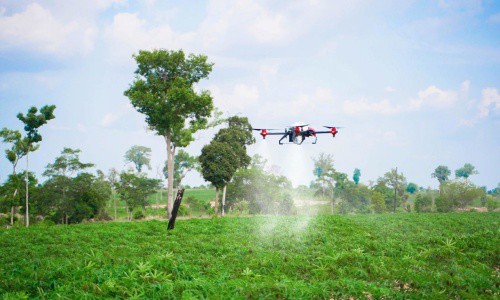Some small-scale cassava farmers in Cambodia are looking into drone technology to achieve higher crop yield and lower costs.
Cassava is the second largest crop grown in the country after rice and it contributes 4% to the GDP growth.
The production, processing and export of cassava has been the key driver of Cambodia's agricultural economy. According to the "National Cassava Policy 2020-2025" issued by Royal Government of Cambodia, the country is positioned to be a home of cassava production and processing industries and becomes a reliable supplier of cassava products for regional and global market
The crop is planted over 600 thousand hectares of farmland, involving intensive labour and time-consuming process. Cassava farming provides employment to thousands of rural workers across Cambodia. Besides food, the crop is turned into flour, paper and alcohol.
Taking a big leap forward
Last month, cassava farmer Chhay Thi became an early adopter of drone technology when he engaged the services of Red Sparrow Cambodia to demonstrate autonomous weeding using an XAG agricultural drone on his 10-hectare cassava field.
Red Sparrow is the local partner of Chinese drone provider XAG.
The drone flew over ridges of cassava plants, sprayed precisely along the pre-set route, and finished eight hectares of herbicide spraying via unmanned control. In the past, the same amount of work usually takes farm workers more than a week to complete manually, but now, it can be done within one hour by only one agricultural drone.
Besides the increased efficiency, drones are helping farmers like Chhay Thi to reduce overall planting costs.
"If I have an XAG drone in busy seasons to help me with crop protection, I can save $8-10 per hectare that is formerly spent on manual spraying. Drone operation also reduces the use of chemical by 10-30%, so the resources and money saved can be reallocated to the other crop cultivation," said Thi, who owns 20 hectares of land in Varin District of the Cambodian province of Siem Reap.
Indeed, while Cambodia’s agriculture sector has an adequate workforce, farm owners are faced with a rising cost up to $18-25 per hectare when they hire workers for pesticide spraying. A group of farm workers can only spray one hectare per day, which would struggle to catch up with the busy season of cassava growth.
Unlike the large agricultural machinery, drones can be transported conveniently and deployed to the field much easier. After the liquid tank was filled with herbicide, the XAG agricultural drone automatically took off as the drone operator played simple clicks on mobile app.
Other benefits of drone technology
In addition to closing the yield gap and reducing costs, using drones protect farmers from chemical exposure.
Cassava crop can grow higher than one meter and sometimes even over the height of human. Traditional spraying requires farmers to either carry backpack sprayers or drive tractors to enter the field. Instead of putting farmers into ground operation, drones can eliminate the health risks of inhaling chemicals and getting poisoned.
The way drone sprays top down from the air successfully prevents direct contact of large ground machinery on cassava crops, ensuring that pesticides or fertilisers can penetrate the plants with precision and avoid crop damage.
Meanwhile, Thi express optimism about drone technology.
"I believe the high efficiency and affordable price will accelerate the scale up of drone operation among more farmers. XAG's agricultural drone can not only help me reap more harvest, but also serve other farmers with the same demand for cassava boom," he said.
Drone technology has showed its various advantages on farm management, from improving crop yield, using less pesticides to safeguarding the well-being of rural workers. As Cambodia is the world's tenth largest producer of cassava with plans for steps forward, XAG anticipates having more cassava farmers to adopt agricultural drone and get better profit in a sustainable way.



